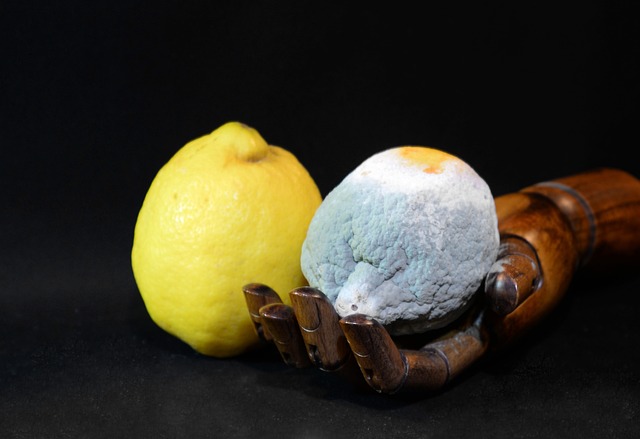Grout sealing is a critical method for preventing mold growth and stains in tiled surfaces by creating a protective barrier that repels liquids and reduces moisture absorption. It's especially important in high-traffic areas or places prone to spills, as it maintains grout aesthetics and prevents stain formation. The market offers silicone and acrylic-based sealants for different needs, with considerations like durability, humidity resistance, and budget. Proper sealing techniques involve thorough cleaning, applying thin layers, and using a clear coating for long-lasting protection against mold and stains, contributing to a healthier living environment.
Understanding Grout and Its Vulnerability to Stains

Grout, a material often used to fill spaces between tiles in floors or walls, is susceptible to staining due to its porous nature. Over time, grout can absorb liquids and substances like dirt, grease, coffee, and wine, leading to unsightly discolouration. Moreover, moisture trapped within the grout can create an ideal environment for mold growth, posing health risks and further damaging the overall appearance of surfaces. To combat these issues, grout sealing has emerged as a crucial method for prevention.
When properly sealed, grout forms a protective barrier against external elements, preventing stains from penetrating its surface. Grout sealants are designed to fill micro-pores, creating a non-porous layer that repels liquids and reduces the chances of mold development. This process is particularly essential in high-traffic areas or spaces prone to spills, ensuring that even with regular cleaning, grout remains stain-free and maintains its aesthetic appeal over an extended period.
The Role of Grout Sealant in Stain Prevention

Types of Grout Sealants Available on the Market

The market offers a diverse range of grout sealants designed for stain prevention, catering to various needs and preferences. These products can be broadly categorized into two main types: silicone-based and acrylic-based sealants. Silicone grout sealants are renowned for their flexibility, durability, and resistance to moisture, making them an excellent choice for high-humidity areas like bathrooms and kitchens. They effectively create a protective barrier, preventing mold growth and repelling water-based stains.
Acrylic-based sealants, on the other hand, provide a cost-effective solution with quick-drying properties. These sealants are versatile and suitable for both indoor and outdoor applications. They offer good stain resistance and can fill microscopic pores in grout, effectively blocking out dirt and stains. The choice between silicone and acrylic depends on factors like desired durability, application area, and personal budget, ensuring effective grout sealing to prevent mold and stains.
How to Choose the Right Grout Sealer for Your Needs

When selecting a grout sealant for stain prevention, understanding your specific needs is key. Different sealers offer varying levels of protection against moisture, stains, and mold growth. Begin by assessing the areas you want to protect – kitchens and bathrooms typically require more robust sealants due to higher humidity levels and frequent contact with water. Check the sealer’s label for certifications indicating its resistance to mold, mildew, and specific types of stains.
Consider the type of grout you have as well. Some sealers are better suited for natural stone or ceramic tiles, while others may be formulated specifically for concrete grouts. Read reviews and compare product specifications to ensure the sealant adheres well to your grout material and provides long-lasting protection. Opting for a high-quality, industry-backed sealer will go a long way in maintaining a stain-free, healthy environment.
Application Techniques for Effective Grout Sealing

When it comes to grout sealing for stain prevention, understanding application techniques is key. The first step involves preparing the surface by thoroughly cleaning and drying the grout areas. This ensures that any existing stains or contaminants are removed, creating a clean canvas for the sealant to bond effectively. Using the right tools is essential; a small brush can help to apply the sealant into tight spaces, while a sponge or cloth is ideal for larger areas.
For optimal results, grout sealing should be done in thin, even layers. Applying too much sealant can lead to bubbling, peeling, or an uneven surface. Allow each coat to dry completely before adding another; this process may take some time but ensures the sealant forms a strong barrier against mold and stains. After the final layer is dry, seal the grout with a clear coating or sealer designed for such purposes, enhancing its durability and protecting it from everyday wear and tear.
Benefits of a Well-Sealed Grout Joint

A well-sealed grout joint offers numerous benefits, particularly in terms of stain and mold prevention. Grout, by nature, is porous, making it susceptible to absorbing moisture and attracting stains, as well as fostering the growth of mold and mildew. Sealing the grout effectively creates a protective barrier that blocks out these unwanted elements, preserving the aesthetic appeal and longevity of your tiled surfaces. This is especially crucial in areas like bathrooms and kitchens where humidity levels are high and water exposure common.
By applying a quality grout sealant, you create a non-porous surface that repels liquid, preventing stains from penetrating the grout lines. Moreover, sealing helps to deter mold and mildew growth by eliminating moisture pockets, which are essential breeding grounds for these organisms. This not only maintains the cleanliness of your tiles but also contributes to a healthier living environment, as mold can trigger allergies and respiratory issues for some individuals.
Common Mistakes to Avoid During the Grout Sealing Process

When it comes to grout sealing for stain prevention, there are several common mistakes that homeowners often make. One of the biggest blunders is neglecting to clean the grout thoroughly before applying any sealant. Dirt, dust, and existing stains can interfere with the adhesion of the sealant, leading to less-than-optimal results. Always ensure the grout is squeaky clean before you begin, using a suitable cleaning solution and a stiff brush to remove all debris.
Another mistake to avoid is selecting the wrong type of grout sealant for your needs. Different sealants have varying levels of durability, water resistance, and aesthetics. If you’re dealing with high-moisture areas like bathrooms or kitchens, opt for a waterproof sealant specifically designed for such environments. Additionally, considering future maintenance is key; some sealants require more frequent reapplication than others, so choose one that aligns with your ability (and budget) to maintain it over time to effectively prevent mold and stains.
Maintenance and Longevity of Sealed Grout

